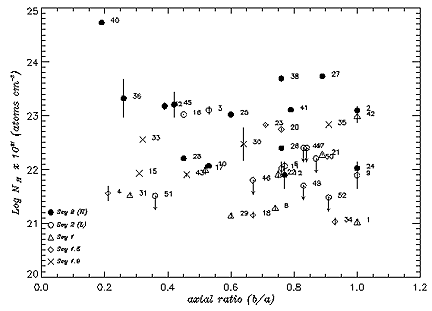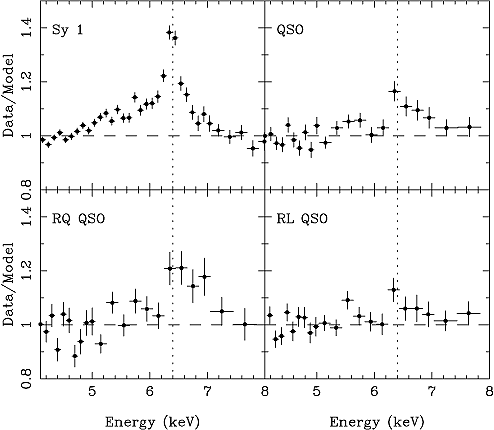Active Galactic Nuclei (AGN)
The HEASARC archive provides a rich database of high-energy observations of AGN, and these data have spawned numerous valuable papers. In particular, the mature archives of ROSAT and ASCA have yielded several important studies of large samples of AGN and we highlight some of the most interesting and relevant ones.The goal of current research on AGN is to understand the fundamental physics of the central power source. A crucial piece of this puzzle is understanding the distribution of gas and dust in the nucleus of an active galaxy, and how this material is transported to and from the central engine. The nature of the circumnuclear gas and dust is most directly constrained when it is observed in absorption against the continuum and line radiation emitted by the inner AGN. Malizia et al. (1997, ApJS 113, 311) combined data from the EXOSAT, Ginga, ROSAT, ASCA, HEAO-1, and BBXRT archives within the HEASARC, to conduct a large-scale study of absorption in AGN. The circumnuclear absorption in AGN often exceeds column densities of NH ~ 1023cm-2 along the line-of-sight (equivalent to extinctions of AV ~ 100) so only X-ray and gamma-ray observations are able to provide a direct view of the nucleus.
Conducting a systematic analysis of data from these combined archives provides the only current method possible for studying column variability because there are so few AGN which have been observed more than once with a single satellite. By examining column densities and axial ratios, Malizia et al. (1997) demonstrated that, in general, the X-ray absorber is not dominated by the interstellar medium in the host galaxy, but is a dense layer of gas whose orientation is unrelated to the inclination of the host. This supports the so-called "Unified Model" for AGN which postulates that the range of optical spectra observed can be explained predominantly by differences in orientation of a toroidal circumnuclear absorber. The Malizia et al. work was a breakthrough study of variability of absorption in AGN, finding that >70% of sources in the sample showed significant absorption variability on time-scale of months to years. The importance of variability studies is the insight gained into the location and geometry of the absorbing gas. While some results had previously been published for a few individual galaxies, the Malizia et al. study provided the strongest evidence up to that point for a location of the X-ray absorber in or near the broad-line-region, and for general complexity of the absorber, which must be ionized or patchy in many sources.

X-ray absorption column plotted against galaxy axial ratio from Malizia et al. (1997).
Seyfert galaxies exhibit iron K- emission lines in their X-ray spectra which are characteristic of relativistic effects in an accretion disk surrounding a central black hole. These lines can be used as a diagnostic of the innermost regions of AGNs. Analysis of the Fe K-
emission lines in their X-ray spectra which are characteristic of relativistic effects in an accretion disk surrounding a central black hole. These lines can be used as a diagnostic of the innermost regions of AGNs. Analysis of the Fe K- line in a sample of quasars, taken from the ASCA archives (Nandra et al. 1997, ApJ 488, L91) revealed a decrease in the line strength with increasing nuclear luminosity. While this effect had been suggested previously, Nandra et al. went on to demonstrate, for the first time, that this relation cannot be solely dependent on radio power because the effect was observed within a radio-quiet subsample. They also noted that the red wing of the line is reduced and the line peak energy increased with nuclear luminosity. Nandra et al. suggested that the line evolution with luminosity is driven by increasing ionization of the accretion disk. For a given black hole mass, the higher luminosity sources must have higher accretion rates and provide a more intense ionizing radiation field. Both would tend to strip electrons from atoms in the accretion disk, which would alter the line emission produced from those atoms in a way which closely matches the observations.
line in a sample of quasars, taken from the ASCA archives (Nandra et al. 1997, ApJ 488, L91) revealed a decrease in the line strength with increasing nuclear luminosity. While this effect had been suggested previously, Nandra et al. went on to demonstrate, for the first time, that this relation cannot be solely dependent on radio power because the effect was observed within a radio-quiet subsample. They also noted that the red wing of the line is reduced and the line peak energy increased with nuclear luminosity. Nandra et al. suggested that the line evolution with luminosity is driven by increasing ionization of the accretion disk. For a given black hole mass, the higher luminosity sources must have higher accretion rates and provide a more intense ionizing radiation field. Both would tend to strip electrons from atoms in the accretion disk, which would alter the line emission produced from those atoms in a way which closely matches the observations.

Average profiles of relativistic iron lines from Nandra et al. (1997).
One of the most important discoveries made using EGRET on CGRO was the existence of gamma-ray luminous AGN. These all belong to a class of AGN called "blazars", whose emission is believed to be dominated by a jet pointed very close to our line-of-sight. The CGRO archive is now used for systematic studies of such objects. Chiang & Mukherjee (1998, ApJ 496, 752) have used the archive to show that pure luminosity evolution explains the distributions of redshift and luminosities observed. They also conclude that only 25% of the diffuse emission measured by SAS 2 and EGRET can be attributed to unresolved gamma-ray blazars and thus other sources of extra-galactic gamma-ray emission must exist. The spatial distribution of sources suspected to be associated with AGN is isotropic, as expected (Ozel & Thompson 1996, ApJ 463, 105). Recently, Wallace et al. (2000, ApJ, in press, astro-ph/0004252) have made a detailed study of the time variability of unidentified EGRET sources on time-scales of days to search for gamma-ray flares characteristic of AGNs; four unidentified sources were found to flare.
Monitoring of such sources at energies of 20 - 100 keV can be performed using CGRO BATSE archival data and measuring the step in flux as the source goes into and comes out of Earth occult. By carefully considering systematic errors and using contemporaneous measurements of selected objects with other instruments, notably CGRO OSSE and BeppoSAX, Malizia et al. (2000, ApJ 531, 642) have been able to study the variability of sources such as 4C 71.07 (20--100keV flux ~ 1.3 x 10-10 erg/cm2/s) on ~ 100-day time-scales. These measurements, contemporaneous with those from EGRET above 30 MeV, indicate a sharp high-energy turnover; perhaps more severe than can be reasonably accounted for by standard synchrotron self-Compton scenarios. The same team have recently improved on this analysis method using detailed background modeling showing that the BATSE archive will continue to be an important resource for studying long-term variability.
Blazars, such as those detected by EGRET, cannot be found in the usual optical surveys for AGN because they do not have strong emission lines. They are usually identified by their combined X-ray and radio emission so X-ray surveys are particularly important for building large samples of blazars. Perlman et al. (1998, AJ 117, 2185; 2000, astro-ph/9910321) have cross-correlated the ROSAT WGACAT with several ground-based databases to find over 200 new blazars. Almost one quarter of these are members of a previously unknown class of X-ray bright, flat spectrum, radio-loud quasars.
|
Science Introduction |
Clusters of Galaxies |
